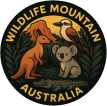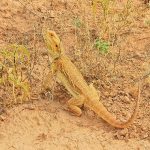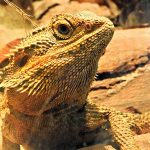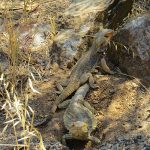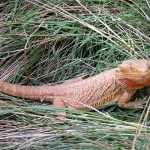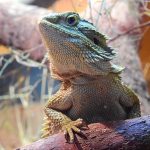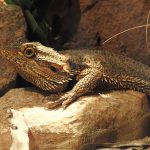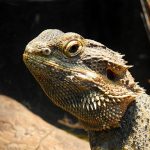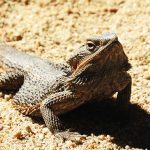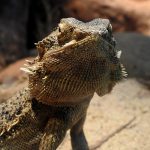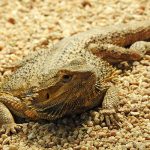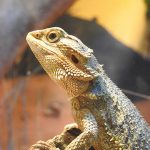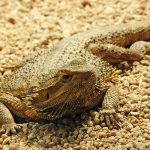CENTRAL BEARDED DRAGON
In the arid heart of Australia you may come across a creature that seems to have stepped straight out of an ancient tale—the Central Bearded Dragon. This remarkable reptile is a true emblem of resilience, perfectly adapted to the harsh landscapes of its home.
Picture a creature with a robust, flattened body covered in rough, spiky scales. Its most distinctive feature is the “beard”—a spiky throat pouch that can puff out and darken, especially when the dragon feels threatened or is trying to impress a mate. These dragons are typically a sandy brown colour, which helps them blend seamlessly into their desert surroundings, though they can exhibit shades of red, orange, or even gold. They can change the shade of their skin to help with temperature regulation or to communicate with other dragons. Mature bearded dragons can reach a total length of around 60 cm, with the tail accounting for more than half of that.
When threatened, they can flatten their bodies and open their mouths wide, displaying their beards to appear larger and more intimidating.
These dragons are native to the central regions of Australia, thriving in arid and semi-arid environments. They are often found basking on rocks or branches in open woodlands, scrublands, and deserts, soaking up the sun’s warmth to regulate their body temperature. Bearded dragons are ectothermic, meaning they rely on external heat sources to regulate their body temperature. You might see them basking in the sun to warm up or retreating to the shade to cool down.
While the Central Bearded Dragon is not known for vocalising like birds or mammals, it communicates through body language. It uses head bobs, arm waves, and changes in the colour of its beard to send signals to other dragons. These gestures can indicate dominance, submission, or readiness to mate. In the fascinating world of these creatures, head bobbing serves as a vital form of communication:
A gentle, slow bowing motion is often used by adult females to indicate submission to a male.
A rapid bobbing gesture is employed by males to assert dominance, frequently accompanied by an inflated or darkened beard.
A vigorous bobbing action occurs just before mating, with males displaying a much more energetic movement that often involves their entire body.
Both males and females may sometimes exhibit quick and intense head bobs, signalling that they are experiencing stress and need some solitude. A male will only wave to show submission to a more dominant male. In contrast, a female will wave and follow it with a slow head bob to indicate her readiness to mate.
As omnivores, they have a varied diet. They feast on insects like crickets and mealworms, as well as vegetation such as leafy greens and fruits. This diverse diet helps them thrive in environments where food sources can be scarce.
Central Bearded Dragons usually breed in the warmer months. Females lay clutches of eggs in burrows they dig into the ground. After about two months, the eggs hatch, and the tiny dragons emerge, ready to explore the world. These hatchlings are independent from birth, relying on instinct to survive.
Central Bearded Dragons can live up to 10 years in the wild. Their longevity is a testament to their adaptability and resilience.
Currently, the Central Bearded Dragon is not considered endangered, however, like many species, it faces challenges from habitat destruction, predation by feral and domestic cats and dogs as well as climate change. Conservation efforts should focus on responsible pet ownership and preserving their natural habitats, ensuring that these environments remain intact and healthy.
The Central Bearded Dragon, with its captivating presence and intriguing behaviours, is a true testament to the wonders of Australian wildlife. As we learn more about these remarkable creatures, we are reminded of the importance of preserving their natural habitats, ensuring that future generations can continue to marvel at their beauty and resilience.
